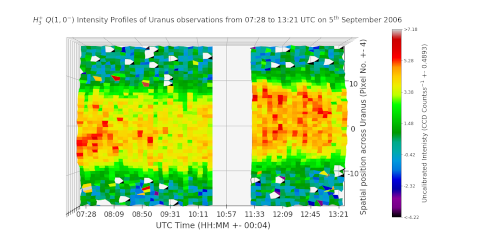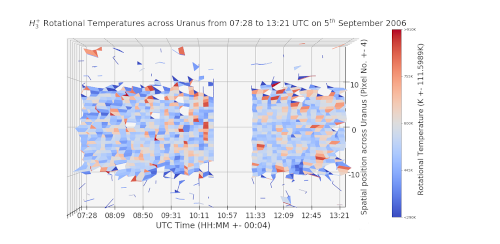Searching for Uranus’s Infrared Aurorae from NIRSPEC Observations
- University of Leicester, Leicester, United Kingdom of Great Britain and Northern Ireland (emt18@leicester.ac.uk)
Abstract
Aurorae at the Gas Giants have been vital in understanding the magnetosphere-ionosphere coupling of these planets. The only aurorae we have detected at Uranus was in the ultraviolet spectrum from Voyager II in 1986 and in 2011 from Earth observations with the Hubble Space Telescope. Previous infrared observations at Uranus have shown promising evidence for infrared aurora but have been unable to confirm these sightings.
Using NIRSPEC observations over a single night in 2006, we aim to spatially resolve the infrared aurorae at Uranus. These are high spectral resolution observations revealing H3+ emission lines from pole-to-pole along the planet’s noon meridian, allowing us to measure H3+ brightness variations, temperature, and column density at all latitudes as a function of time. Our initial investigation shows local time peaks of H3+ emission intensities in the northern and southern half of observations, with no significant variations of ro-vibrational temperatures recorded. This strongly suggests that the H3+ brightness variation is driven by short timescale H3+ density variations, indicating these intensity peaks must occur due to other processes, such as the aurorae.
1. Introduction
Our understanding of the aurora of Uranus comes almost entirely from past ultraviolet observations of the planet, both from Voyager II’s flyby, which produced a complete mapping of these aurorae in the UV spectrum [1] and then, more recently, from the detections of bright auroral spots using the Hubble Space Telescope [2]. Since the first detection of H3+ at Uranus in 1992 [3], there has been a sustained effort to successfully detect the Uranian aurorae in the infrared. Due to the weak emission from Uranus [3] and limitations in spatial resolution (R < 2,500 [4]) of previous data, producing a map of Infrared emissions has posed a problem [5].
These past observations have either shown apparent enhancement in H3+ density from average emission across the entire disk of Uranus on individual observation nights [4], or have revealed localized brightening on the disk of the planet without resolving the temperature and H3+ density, thus not proving an auroral origin for the brightness enhancement [5] [6].
Using the Near InfraRed SPECtrometer on the Keck II telescope (R ~ 20,000), we have investigated a night of observations to detect local time variations in H3+ emissions and to measure the ro-vibrational temperatures, to determine the cause of these emissions, if auroral.
2. NIRSPEC Observations and Data Selection
Observations were taken between 07:26 and 13:23 UTC on 5th September 2006 with NIRSPEC on the Keck II Telescope. Using a 0.288x24” slit aligned to the planet’s N-S rotational axis, a total 224 spectro-images were analyzed. To mitigate the effects of sky emission in our data, we present a final 54 emission spectra sets. These contain five H3+ emission lines of the Q branch, between 3.9447 and 4.0042µm.
Measurements from Q(1,0-) and Q(3,0-) emission lines were taken due to their higher signal-to-noise ratio. By fitting the brightness (intensity) of both lines across all 54 datasets, local time variations can be measured. Due to a break (calibration star observations) and slit unalignment (between 10:52 and 11:31 UTC), data is left blank.
3. H3+ Emission Intensities
All 54 datasets were stacked horizontally with increasing time (Q(1,0-) emissions in Figure 1). Any vacant pixels correspond to anomalous data points.

Figure 1: Local time variability of Q(1,0-) intensities across the slit. The pixel colour is dependent on intensity value, shown by the colour bar (right).
Between 07:28 and 08:15 UTC, we observe significant intensity peaks across Uranus (between 25% and 62% above local mean intensity). These peaks predominately occur in the negative spatial pixels where intensities are >20% greater than their positive counterparts. Between 11:27 and 13:03 UTC similar peaks of intensity are observed (between 12% and 49% above local mean intensity). In comparison, the intensities in the positive spatial pixels are >12% greater than the negative half but show no significant increase from earlier observations.
4. H3+ Ro-vibrational Temperatures

Figure 2: Temporal and spatial variability of H3+ temperature. The pixel colour is dependent on intensity value, shown by the colour bar (right).
Overall, a mean ro-vibrational temperature of 547K was measured between 07:28 and 08:15 UTC, 2% below the total mean temperature. A 1% increase in mean ro-vibrational temperature was observed between 11:27 and 13:03 UTC. We hence suggest that the ro-vibrational temperatures are not the cause of peak intensities in Figure 1.
5. Summary and Conclusions
Our initial findings show H3+ peaks between 07:28 to 08:15 UTC with further peaks observed between 11:27 and 13:03 UTC. These peaks appear independent to the ro-vibrational temperatures (which remains mostly constant). The latitudinal locations of these emissions across Uranus’s disk tied in with minimal thermal variation suggests that these emissions could be a result of the northern and southern aurorae of Uranus. If this is so, this makes our findings the first to spatially resolve Uranus’s infrared aurorae. Further work will involve column density measurements, with future work investigating ion velocities to understand ionospheric flows. Additionally, we will map this data across a 3D model of Uranus, to compare our findings with previous investigations of Uranus’s aurorae.
Acknowledgements
Emma Thomas was supported by an STFC studentship at the University of Leicester. All the data presented herein were obtained at the W.M. Keck Observatory, which is operated as a scientific partnership among the California and the National Aeronautics and Space Administration. The Observatory was made possible by the generous financial support of the W. M. Keck Foundation.
References
[1] Herbert, F. and Sandel, B.R., 1994. JGR Space Physics, 99(A3), pg. 4143-4160.
[2] Lamy, L., et al, 2012. Geophysical Research Letters, 39(7).
[3] Trafton, L.M., et al, 1993. The Astrophysical Journal, 524, pg. 1059-1083.
[4] Melin, H., et al, 2011. Astrophysical Journal, 729:134, pg. 9.
[5] Lam, H.A., et al, 1996. The Astrophysical Journal, 474, pg. 73-76.
[6] Melin, H. et al, 2019. Phil. Trans. R. Soc. A, 377: 20180408.
How to cite: Thomas, E., Stallard, T., Melin, H., and Chowdhury, N.: Searching for Uranus’s Infrared Aurorae from NIRSPEC Observations, Europlanet Science Congress 2020, online, 21 Sep–9 Oct 2020, EPSC2020-797, https://doi.org/10.5194/epsc2020-797, 2020.

